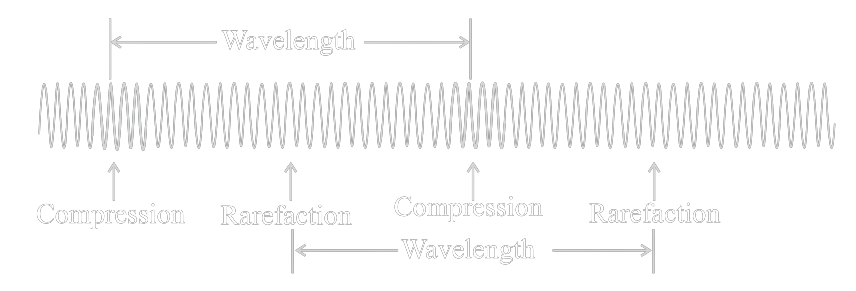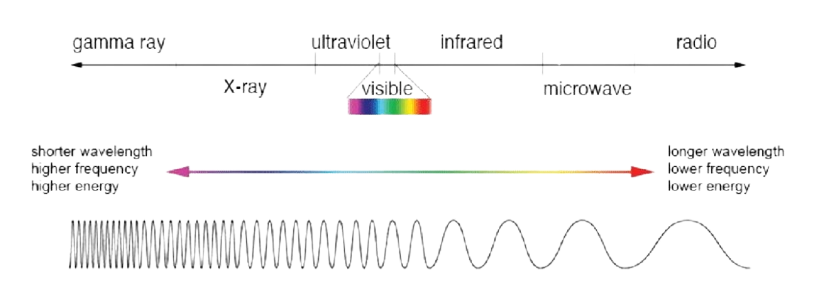Physics
Waves
A wave is a series of oscillations (vibrations) that transfer energy from one place to another.
We can categorize waves into two types:
Longitudinal waves
Transverse waves
Longitudinal Waves
Longitudinal waves are waves with oscillations (vibrations) parallel to the direction of the wave (direction of energy being transferred).

Compression: A region of high pressure, particles are close together
Rarefaction: Region of low pressure, particles are further apart
Examples of longitudinal waves: Sound, ultrasound, seismic P-waves.
The speed of sound in air is 320m/s.
Transverse Waves
Transverse waves are waves where the oscillations (vibrations) are perpendicular (90°) to the direction of the wave (direction of energy being transferred).
Examples of transverse waves: Light, gamma, radio waves.
The speed of light is: 3x10⁸ m/s (300,000,000 meters per second) (this applies to all electromagnetic waves).
All objects have a natural frequency. If this frequency is reached, the objects will increase its amplitude. This is known as resonance.
Visible light is only a small part of the electromagnetic spectrum.
The EM spectrum is continuous. This is evident when looking at a rainbow, as there are no gaps between the colors.
An electromagnetic wave is an oscillation of electric and magnetic fields. It is a transverse wave.
Wave speed = wavelength x frequency
The units for these quantities are as follows:
Wave speed - m/s
Wavelength - m
frequency - Hz
Wavelength and frequency are inversely proportional.
Electromagnetic Spectrum
All electromagnetic waves are transverse, they all travel at 3×108 m/s in a vaccuum.
 This (unclear) image shows the electromagnetic spectrum ordered from highest frequency to lowest. It is usually ordered the other way around.
This (unclear) image shows the electromagnetic spectrum ordered from highest frequency to lowest. It is usually ordered the other way around.
Uses:
Radio waves → Communication
Microwaves → Communication - Mobile phones
Infrared Light → Thermal imaging, remote controls, communication (fiber optic cables)
Visible light → Communication (fiber optic cables)
They carry high rate of data/information
Glass is transparent to visible light - (TIR happens)
Ultraviolet Light → Sterilize surfaces. tanning, analyzing crime scenes, forgery (bank notes)
X-rays → Scanning bones, security scans (airport baggage)
Gamma rays → Sterilize surgical equipment, treating cancer (gamma knife)
A common exam question is:
Why are microwaves used for mobile phone signals?
The answer is:
Microwaves only need short aerials
Microwaves penetrate walls
Another common question is:
Name some examples of damage caused by x-rays.
The answer would be:
Mutation
Cause cancer
Damage cell tissue
Another one is:
Suggest and explain precautions for the safe use of x-rays
The answer is:
Use a screen (lead) to absorb radiation.
Distance from the source, reduce the amount of radiation
Maximum number of x-rays (to limit the dose)
Communication
Basic Components of a communication system:
Sender → Channel → Receiver
Signals are sent along this path, two types of signals are possible:
Analogue signals are an example of continuous data with an infinite range of values
Electricity
The components of a circuit
Battery/Cell - Supplies electrons with energy and pushes electrons around the circuit with what we call electromotor force
Wire - Transmits electron flow from cell to output
Resistor - Limits/regulates electron flow
Bulb - Is the output, will light up if powered
Variable resistor - A resistor that can change its resistance
In an insulator, electricity will not conduct as the electrons are localized (not free to move)
In a conductor, electricity will conduct as the electrons are delocalized (free to move)
A current is the flow of charge.
In a metal, the electrons are free to move through the object, electrons have a negative charge.
Charge is measured in coulomb (c)
The charge of 1 electron is -1.6×10-19C